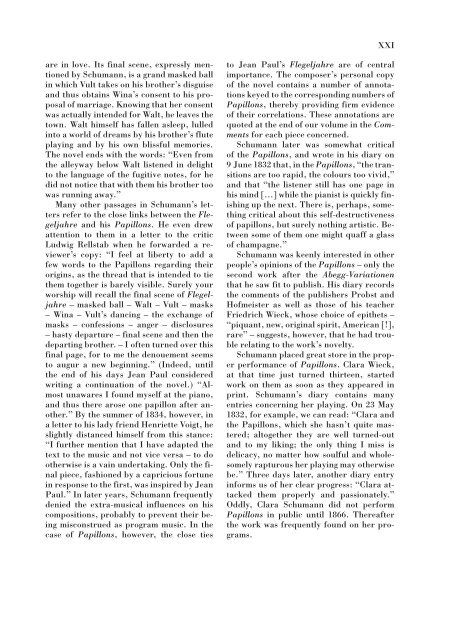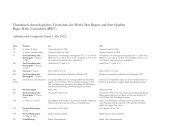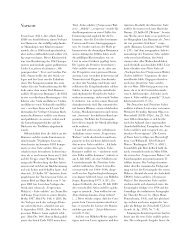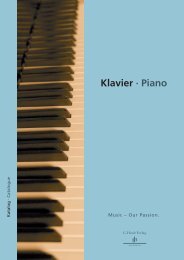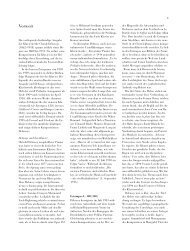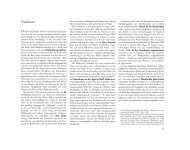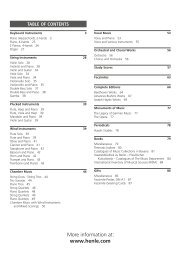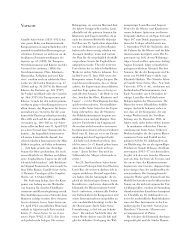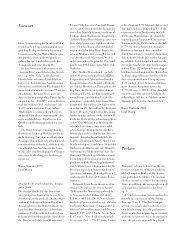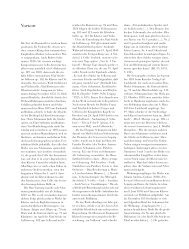Vorwort (PDF, 1698 KB) - Henle Verlag
Vorwort (PDF, 1698 KB) - Henle Verlag
Vorwort (PDF, 1698 KB) - Henle Verlag
You also want an ePaper? Increase the reach of your titles
YUMPU automatically turns print PDFs into web optimized ePapers that Google loves.
XXI<br />
are in love. Its final scene, expressly mentioned<br />
by Schumann, is a grand masked ball<br />
in which Vult takes on his brother’s disguise<br />
and thus obtains Wina’s consent to his proposal<br />
of marriage. Knowing that her consent<br />
was actually intended for Walt, he leaves the<br />
town. Walt himself has fallen asleep, lulled<br />
into a world of dreams by his brother’s flute<br />
playing and by his own blissful memories.<br />
The novel ends with the words: “Even from<br />
the alleyway below Walt listened in delight<br />
to the language of the fugitive notes, for he<br />
did not notice that with them his brother too<br />
was running away.”<br />
Many other passages in Schumann’s letters<br />
refer to the close links between the Flegel<br />
jahre and his Papillons. He even drew<br />
attention to them in a letter to the critic<br />
Ludwig Rellstab when he forwarded a reviewer’s<br />
copy: “I feel at liberty to add a<br />
few words to the Papillons regarding their<br />
origins, as the thread that is intended to tie<br />
them together is barely visible. Surely your<br />
worship will recall the final scene of Flegeljahre<br />
– masked ball – Walt – Vult – masks<br />
– Wina – Vult’s dancing – the exchange of<br />
masks – confessions – anger – disclosures<br />
– hasty departure – final scene and then the<br />
departing brother. – I often turned over this<br />
final page, for to me the denouement seems<br />
to augur a new beginning.” (Indeed, until<br />
the end of his days Jean Paul considered<br />
writing a continuation of the novel.) “Almost<br />
unawares I found myself at the piano,<br />
and thus there arose one papillon after another.”<br />
By the summer of 1834, however, in<br />
a letter to his lady friend Henriette Voigt, he<br />
slightly distanced himself from this stance:<br />
“I further mention that I have adapted the<br />
text to the music and not vice versa – to do<br />
otherwise is a vain undertaking. Only the final<br />
piece, fashioned by a capricious fortune<br />
in response to the first, was inspired by Jean<br />
Paul.” In later years, Schumann frequently<br />
denied the extra-musical influences on his<br />
compositions, probably to prevent their being<br />
misconstrued as program music. In the<br />
case of Papillons, however, the close ties<br />
to Jean Paul’s Flegeljahre are of central<br />
importance. The composer’s personal copy<br />
of the novel contains a number of annotations<br />
keyed to the corresponding numbers of<br />
Papillons, thereby providing firm evidence<br />
of their correlations. These annotations are<br />
quoted at the end of our volume in the Comments<br />
for each piece concerned.<br />
Schumann later was somewhat critical<br />
of the Papillons, and wrote in his diary on<br />
9 June 1832 that, in the Papillons, “the transitions<br />
are too rapid, the colours too vivid,”<br />
and that “the listener still has one page in<br />
his mind […] while the pianist is quickly finishing<br />
up the next. There is, perhaps, something<br />
critical about this self-destructiveness<br />
of papillons, but surely nothing artistic. Between<br />
some of them one might quaff a glass<br />
of champagne.”<br />
Schumann was keenly interested in other<br />
people’s opinions of the Papillons – only the<br />
second work after the Abegg-Variationen<br />
that he saw fit to publish. His diary records<br />
the comments of the publishers Probst and<br />
Hofmeister as well as those of his teacher<br />
Friedrich Wieck, whose choice of epithets –<br />
“piquant, new, original spirit, American [!],<br />
rare” – suggests, however, that he had trouble<br />
relating to the work’s novelty.<br />
Schumann placed great store in the proper<br />
performance of Papillons. Clara Wieck,<br />
at that time just turned thirteen, started<br />
work on them as soon as they appeared in<br />
print. Schumann’s diary contains many<br />
entries concerning her playing. On 23 May<br />
1832, for example, we can read: “Clara and<br />
the Papillons, which she hasn’t quite mastered;<br />
altogether they are well turned-out<br />
and to my liking; the only thing I miss is<br />
delicacy, no matter how soulful and wholesomely<br />
rapturous her playing may otherwise<br />
be.” Three days later, another diary entry<br />
informs us of her clear progress: “Clara attacked<br />
them properly and passionately.”<br />
Oddly, Clara Schumann did not perform<br />
Papillons in public until 1866. Thereafter<br />
the work was frequently found on her programs.


